Thai Boxing (or Muaythaï)
Thai Boxing, a martial arts
Thai Boxing (also known Muaythai – people’s boxing – or Thai Boxing), which was created by the Thai military, is a sport that originated in the fifteenth century. Renowned internationally for its efficiency and its spectacular nature, Thai Boxing is governed by a strict code of ethics including respect of the rules and of one’s partner, among others.
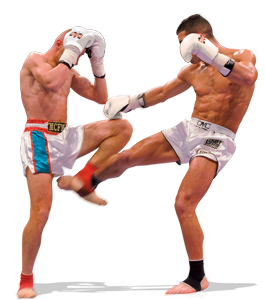
The two Thai boxing fighters (“nakmuay”), under the supervision of an arbitral body, compete in the ring over several rounds, according to weight category and level, making use of so-called percussion (feet, fist, elbow, and knee blows), capture and projection techniques. The blows are made to areas that are authorised (the thighs, front and side of the chest, and the face).
The fighters wear regulatory protection in the form of gloves, mouth guards, cups, and additional protections depending on the sex (chest protector for women), age, and level of the competitor.
Each Muaythai meet is preceded by meditation (“Wai Khru”) and a ceremonial ritual (“Ram Muay”), which is accompanied by specific music. For this ceremony the “Mong Kong” (a type of headband) is worn on the head. The term “Waï Khru” literally means “greeting the teacher.”
By extension, the entire ceremony has also become the greeting that the “Nakmuay” offers to their opponent, the judges, referees, officials and the public.
Thai Boxing, martial arts, self defence and fitness,
Thai Boxing, which at its origin was an art of war, is successfully practised as Self-Defence and Fitness activities.
Thai Boxing, a traditional art
In addition to these traditional origins, Muaythai includes traditional techniques for neutralising one’s opponent without weapons (Muay Boran) as well as with (Krabi Krabong).
Like any martial art, progress in Thai-Boxing is conditioned by the knowledge of techniques and the acquisition of certain moral values. These stages of development are validated by grades called “Prajeet” and “Khan”.
Background
The military origin
Muaythai has been a part of Thai history and heritage for hundreds of years, as with most traditions from ancient times. Many different versions of the history of Muaythai exist, but all sources agree that Muaythai was the primary and most effective method of self defence used by Thai warriors on the battlefields of conflicts and wars that occurred countless times throughout the history of the nation now known as Thailand. During this time, a warfare manual named “Chupasart” was written. This manual emphasised the martial uses of each body part. The underlying philosophy of this manual implied that fighting was more than the use of weapons, but most importantly, should engage total commitment from mind, body and soul.
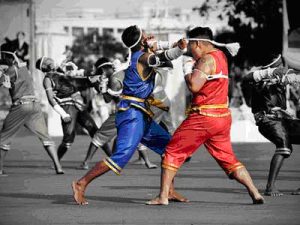 Its emergence as a sport
Its emergence as a sport
The first known practice of Muaythai as a “sport”, off and away from the heat and chaos of the battlefield occurred during the reign of King Prachao Sua (1697-1709 A.D.). With a great love of the combat art he often fought incognito in local village contests, often beating the local champions. When the nation was at peace, to keep the army busy he often ordered them to train in Muaythai. It was from this that loosely organised competitions started sprouting up around the country.
The legendary Nai Khanom Tom
In 1774, the legendary Nai Khanom Dtom made Muaythai famous for his battle against a group of Burmese while he was a prisoner of war in Burma. He was captured when the Burmese ransacked and burnt Thailand’s ancient capital Ayuddhaya. He legendarily defeated ten of Burma’s best boxers when, without pause, he took them on one by one through a battering and bruising contest. He illustrated one of the most favourable elements in Muaythai, an indomitable will to win for honour and willingness to face any odds. This can be summarised as: “Nothing can stand against you except yourself”.
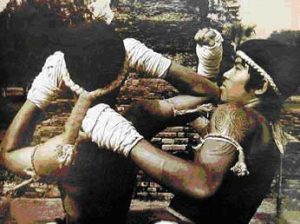
The army has fostered Muaythai
Muaythai—an integral part of Thailand
. Soldiers have trained and used Muaythai techniques for as long as there has been an army in Thailand. For the military, it has always had use for the close combat fighting skills, the martial art of the battlefield. When a Thai soldier fights hand to hand he uses Muaythai. But then so does every Thai person, male or female. Watching it, learning it, and copying it is a part of Thai childhood. Muaythai soon became a favourite sporting pastime for people from all walks of life, with training camps being established all over the country.
Muaythai in the twentieth century—an internationally renowned sport
In the early 1930s, Muaythai was officially codified, with rules and regulations being created and introduced into the sporting world, to make Muaythai an international sport of the early 20th century and a safe ring sport. Round contests were introduced along with eight divisions based on international boxing. Queensbury rules boxing gloves replaced the rope bindings on the fighters’ hands.
With a centuries long history, Muaythai has progressed and is now recognised in many countries worldwide, creating a new era of a proud world history. In recent years Muaythai, both amateur and professional, has swept across the world like wildfire and developed into a premier ring sport – a fighting art with no equal in terms of unarmed combat and spectator appeal, as well as being a form of self defence and a fitness programme.
The IFMA (International Federation of Muaythai Amateur)
www.ifmamuaythai.org
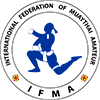
Inaugurated in 1993, the International Federation of Muaythai Amateur (“IFMA” International Federation of Muaythai Amateur) is composed of 128 member countries grouped around five continental federations united under a single regulatory body. The WMC is the only partner recognised by the IFMA
The IFMA is the only international federation of amateur Muaythai recognised in the world, that promotes the sport and art of Muaythai.
In 1998, the IFMA was officially recognised by the Asian Olympic Committee.
In 2005, during the 23rd Asian Games of the Southeast in Manila, Thai boxing, under the aegis of the IFMA, acquired the status of an Olympic sport where men and women could compete in the disciplines of Muaythai and Wai Khru.
In 2006, IFMA was recognised by SportAccord (formerly “General Association of International Sports Federations,” GAISF).
In 2008, the World Championships of the IFMA, member of the Trim and Fitness International Sport for All (“TAFISA”) was organised under the patronage of the International Olympic Committee (IOC). IFMA promote Muaythai with disadvantaged youth as a means of social development.
In January 2011, the IFMA signed a memorandum of understanding with the “Peace and Sport” organisation under the Honorary Presidency of HSH Prince Albert II of Monaco and chaired by Mr . Joël BOUZOU— an agreement that reinforces the action of the IFMA in the transmission of Muaythai values, culture, and traditions, to children.
In April 2012, the IFMA launched, in cooperation with the “Peace and Sport”organisation, the “sport is your gang” project using Muaythai to improve the lives of disadvantaged and marginalised youth.
The IFMA programme for children in over 40 countries received the praise of the IOC members. In addition, the “Muaythai against Drugs” programme brought together Thai and Jamaican youth during a demonstration of the sport.
In 2010, the IFMA participated in the SportAccord “World Combat Games” in Beijing, bringing together the largest number of participants and spectators. The same year, the King’s Cup in Bangkok was broadcast live for the first time in the United States.
In April 2012, the IFMA launched the “Muaythai aims for the IOC” campaign. During a gala event, it submitted its letter of intent to the International Olympic Committee requesting Olympic recognition of Muaythai. At the same time, a request for participation in the World Games in 2017 has been filed with the International World Games Association.
THE WORLD MUAYTHAI COUNCIL
www.wmcmuaythai.org

The WMC is the supreme regulatory authority of Thai boxing, both in Thailand and around the world. It is a democratic organisation that holds elections every four years.
Constituted by the Government and recognised by the Thai sports authority
Implemented by a parliamentary resolution, the WMC is constituted by the Government and recognised by the Thai sports authority, in collaboration with the highest sports authorities of all Member States to regulate all aspects of the Muay Thai art and sport.
120 member countries promote excellence in the art of Muay Thai
Inaugurated in 1995 with 39 member countries, the WMC is currently composed of 120 countries.
The Council’s main objective is to maintain and promote excellence in the art of Muaythai, mainly as a form of cultural art, as well as self-defence and a popular ring sport. Under these objectives, the WMC follows the governmental guidelines for regulating all Muay Thai competitions in the world, in conformity with the government-approved statutes.
The leaders of the WMC
The Honorary President is S.E. General Pichitr Kullavanijaya, Privy Councillor to His Majesty the King of Thailand.
The President, General Chetta Thanajaro was the first defence minister, the first commander of the Royal Thai Army, and the Honorary President of the Olympic Committee of Thailand.
The Council and the Executive Committees are composed of highly respected personalities selected from more than 80 countries worldwide. Among others, the Prime Minister of the Republic of Kazakhstan, the Chairman of the Sports Council in Seoul, and the mayor of Odessa are members. The first governor of the Sports Authority of Thailand, Dr. Sakchye Tapsuwan is the Secretary General and a Muaythai personality. Stephan Fox is the Vice President and International Coordinator.
Close links of the WMC with the IFMA
The WMC has close links with the International Federation of Muay Thai Amateur (IFMA), which was created to make Muay Thai an Olympic sport. In order to enable professional and amateur structures to work together, many WMC officials also occupy different positions within the IFMA.
The WMC and IFMA, with their members, work to build a solid foundation for our sport, as the slogan says—”one world – one Muay Thai. ”
The Monegasque Federation of Muaythai and Associated Disciplines
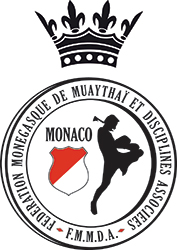 The Monegasque Federation of Muaythai and Associated Disciplines
The Monegasque Federation of Muaythai and Associated Disciplines, founded in 2001 , whose founder President is Mr. Claude POUGET , is :
– Approved by the Government of Monaco and recognized by the Monegasque Olympic Committee ;
– Affiliated since its origin to the I.F.M.A. (International Federation Muaythai Amateur) , a member of Sport Accord Federations’ Unions, recognized by the International Olympic Committee;
– Partner of the World Muaythai Council, only organization recognized by the Pro I.F.M.A.
The
International Martial Arts Academy of Monaco, presided by Mrs Felicia POUGET is affiliated with the Monegasque Federation of Muaythai and Associated Disciplines
Les Monte-Carlo Fighting Masters & Trophies & la WMC

A ce jour, depuis 2013, quatre éditions des Monte-Carlo Fighting Masters (2013, 2014, 2016) ou ( des Monte-Carlo Fighting Trophy (2017) ont été organisées :
Au total : 7 championnats du monde de Muaythai (2014) !
 The two Thai boxing fighters (“nakmuay”), under the supervision of an arbitral body, compete in the ring over several rounds, according to weight category and level, making use of so-called percussion (feet, fist, elbow, and knee blows), capture and projection techniques. The blows are made to areas that are authorised (the thighs, front and side of the chest, and the face).
The fighters wear regulatory protection in the form of gloves, mouth guards, cups, and additional protections depending on the sex (chest protector for women), age, and level of the competitor.
Each Muaythai meet is preceded by meditation (“Wai Khru”) and a ceremonial ritual (“Ram Muay”), which is accompanied by specific music. For this ceremony the “Mong Kong” (a type of headband) is worn on the head. The term “Waï Khru” literally means “greeting the teacher.”
By extension, the entire ceremony has also become the greeting that the “Nakmuay” offers to their opponent, the judges, referees, officials and the public.
Thai Boxing, martial arts, self defence and fitness,
Thai Boxing, which at its origin was an art of war, is successfully practised as Self-Defence and Fitness activities.
Thai Boxing, a traditional art
In addition to these traditional origins, Muaythai includes traditional techniques for neutralising one’s opponent without weapons (Muay Boran) as well as with (Krabi Krabong).
Like any martial art, progress in Thai-Boxing is conditioned by the knowledge of techniques and the acquisition of certain moral values. These stages of development are validated by grades called “Prajeet” and “Khan”.
The two Thai boxing fighters (“nakmuay”), under the supervision of an arbitral body, compete in the ring over several rounds, according to weight category and level, making use of so-called percussion (feet, fist, elbow, and knee blows), capture and projection techniques. The blows are made to areas that are authorised (the thighs, front and side of the chest, and the face).
The fighters wear regulatory protection in the form of gloves, mouth guards, cups, and additional protections depending on the sex (chest protector for women), age, and level of the competitor.
Each Muaythai meet is preceded by meditation (“Wai Khru”) and a ceremonial ritual (“Ram Muay”), which is accompanied by specific music. For this ceremony the “Mong Kong” (a type of headband) is worn on the head. The term “Waï Khru” literally means “greeting the teacher.”
By extension, the entire ceremony has also become the greeting that the “Nakmuay” offers to their opponent, the judges, referees, officials and the public.
Thai Boxing, martial arts, self defence and fitness,
Thai Boxing, which at its origin was an art of war, is successfully practised as Self-Defence and Fitness activities.
Thai Boxing, a traditional art
In addition to these traditional origins, Muaythai includes traditional techniques for neutralising one’s opponent without weapons (Muay Boran) as well as with (Krabi Krabong).
Like any martial art, progress in Thai-Boxing is conditioned by the knowledge of techniques and the acquisition of certain moral values. These stages of development are validated by grades called “Prajeet” and “Khan”.
 Its emergence as a sport
The first known practice of Muaythai as a “sport”, off and away from the heat and chaos of the battlefield occurred during the reign of King Prachao Sua (1697-1709 A.D.). With a great love of the combat art he often fought incognito in local village contests, often beating the local champions. When the nation was at peace, to keep the army busy he often ordered them to train in Muaythai. It was from this that loosely organised competitions started sprouting up around the country.
The legendary Nai Khanom Tom
In 1774, the legendary Nai Khanom Dtom made Muaythai famous for his battle against a group of Burmese while he was a prisoner of war in Burma. He was captured when the Burmese ransacked and burnt Thailand’s ancient capital Ayuddhaya. He legendarily defeated ten of Burma’s best boxers when, without pause, he took them on one by one through a battering and bruising contest. He illustrated one of the most favourable elements in Muaythai, an indomitable will to win for honour and willingness to face any odds. This can be summarised as: “Nothing can stand against you except yourself”.
Its emergence as a sport
The first known practice of Muaythai as a “sport”, off and away from the heat and chaos of the battlefield occurred during the reign of King Prachao Sua (1697-1709 A.D.). With a great love of the combat art he often fought incognito in local village contests, often beating the local champions. When the nation was at peace, to keep the army busy he often ordered them to train in Muaythai. It was from this that loosely organised competitions started sprouting up around the country.
The legendary Nai Khanom Tom
In 1774, the legendary Nai Khanom Dtom made Muaythai famous for his battle against a group of Burmese while he was a prisoner of war in Burma. He was captured when the Burmese ransacked and burnt Thailand’s ancient capital Ayuddhaya. He legendarily defeated ten of Burma’s best boxers when, without pause, he took them on one by one through a battering and bruising contest. He illustrated one of the most favourable elements in Muaythai, an indomitable will to win for honour and willingness to face any odds. This can be summarised as: “Nothing can stand against you except yourself”.
 The army has fostered Muaythai
Muaythai—an integral part of Thailand
. Soldiers have trained and used Muaythai techniques for as long as there has been an army in Thailand. For the military, it has always had use for the close combat fighting skills, the martial art of the battlefield. When a Thai soldier fights hand to hand he uses Muaythai. But then so does every Thai person, male or female. Watching it, learning it, and copying it is a part of Thai childhood. Muaythai soon became a favourite sporting pastime for people from all walks of life, with training camps being established all over the country.
Muaythai in the twentieth century—an internationally renowned sport
In the early 1930s, Muaythai was officially codified, with rules and regulations being created and introduced into the sporting world, to make Muaythai an international sport of the early 20th century and a safe ring sport. Round contests were introduced along with eight divisions based on international boxing. Queensbury rules boxing gloves replaced the rope bindings on the fighters’ hands.
With a centuries long history, Muaythai has progressed and is now recognised in many countries worldwide, creating a new era of a proud world history. In recent years Muaythai, both amateur and professional, has swept across the world like wildfire and developed into a premier ring sport – a fighting art with no equal in terms of unarmed combat and spectator appeal, as well as being a form of self defence and a fitness programme.
The army has fostered Muaythai
Muaythai—an integral part of Thailand
. Soldiers have trained and used Muaythai techniques for as long as there has been an army in Thailand. For the military, it has always had use for the close combat fighting skills, the martial art of the battlefield. When a Thai soldier fights hand to hand he uses Muaythai. But then so does every Thai person, male or female. Watching it, learning it, and copying it is a part of Thai childhood. Muaythai soon became a favourite sporting pastime for people from all walks of life, with training camps being established all over the country.
Muaythai in the twentieth century—an internationally renowned sport
In the early 1930s, Muaythai was officially codified, with rules and regulations being created and introduced into the sporting world, to make Muaythai an international sport of the early 20th century and a safe ring sport. Round contests were introduced along with eight divisions based on international boxing. Queensbury rules boxing gloves replaced the rope bindings on the fighters’ hands.
With a centuries long history, Muaythai has progressed and is now recognised in many countries worldwide, creating a new era of a proud world history. In recent years Muaythai, both amateur and professional, has swept across the world like wildfire and developed into a premier ring sport – a fighting art with no equal in terms of unarmed combat and spectator appeal, as well as being a form of self defence and a fitness programme.
 Inaugurated in 1993, the International Federation of Muaythai Amateur (“IFMA” International Federation of Muaythai Amateur) is composed of 128 member countries grouped around five continental federations united under a single regulatory body. The WMC is the only partner recognised by the IFMA
The IFMA is the only international federation of amateur Muaythai recognised in the world, that promotes the sport and art of Muaythai.
In 1998, the IFMA was officially recognised by the Asian Olympic Committee.
In 2005, during the 23rd Asian Games of the Southeast in Manila, Thai boxing, under the aegis of the IFMA, acquired the status of an Olympic sport where men and women could compete in the disciplines of Muaythai and Wai Khru.
In 2006, IFMA was recognised by SportAccord (formerly “General Association of International Sports Federations,” GAISF).
In 2008, the World Championships of the IFMA, member of the Trim and Fitness International Sport for All (“TAFISA”) was organised under the patronage of the International Olympic Committee (IOC). IFMA promote Muaythai with disadvantaged youth as a means of social development.
In January 2011, the IFMA signed a memorandum of understanding with the “Peace and Sport” organisation under the Honorary Presidency of HSH Prince Albert II of Monaco and chaired by Mr . Joël BOUZOU— an agreement that reinforces the action of the IFMA in the transmission of Muaythai values, culture, and traditions, to children.
In April 2012, the IFMA launched, in cooperation with the “Peace and Sport”organisation, the “sport is your gang” project using Muaythai to improve the lives of disadvantaged and marginalised youth.
The IFMA programme for children in over 40 countries received the praise of the IOC members. In addition, the “Muaythai against Drugs” programme brought together Thai and Jamaican youth during a demonstration of the sport.
In 2010, the IFMA participated in the SportAccord “World Combat Games” in Beijing, bringing together the largest number of participants and spectators. The same year, the King’s Cup in Bangkok was broadcast live for the first time in the United States.
In April 2012, the IFMA launched the “Muaythai aims for the IOC” campaign. During a gala event, it submitted its letter of intent to the International Olympic Committee requesting Olympic recognition of Muaythai. At the same time, a request for participation in the World Games in 2017 has been filed with the International World Games Association.
Inaugurated in 1993, the International Federation of Muaythai Amateur (“IFMA” International Federation of Muaythai Amateur) is composed of 128 member countries grouped around five continental federations united under a single regulatory body. The WMC is the only partner recognised by the IFMA
The IFMA is the only international federation of amateur Muaythai recognised in the world, that promotes the sport and art of Muaythai.
In 1998, the IFMA was officially recognised by the Asian Olympic Committee.
In 2005, during the 23rd Asian Games of the Southeast in Manila, Thai boxing, under the aegis of the IFMA, acquired the status of an Olympic sport where men and women could compete in the disciplines of Muaythai and Wai Khru.
In 2006, IFMA was recognised by SportAccord (formerly “General Association of International Sports Federations,” GAISF).
In 2008, the World Championships of the IFMA, member of the Trim and Fitness International Sport for All (“TAFISA”) was organised under the patronage of the International Olympic Committee (IOC). IFMA promote Muaythai with disadvantaged youth as a means of social development.
In January 2011, the IFMA signed a memorandum of understanding with the “Peace and Sport” organisation under the Honorary Presidency of HSH Prince Albert II of Monaco and chaired by Mr . Joël BOUZOU— an agreement that reinforces the action of the IFMA in the transmission of Muaythai values, culture, and traditions, to children.
In April 2012, the IFMA launched, in cooperation with the “Peace and Sport”organisation, the “sport is your gang” project using Muaythai to improve the lives of disadvantaged and marginalised youth.
The IFMA programme for children in over 40 countries received the praise of the IOC members. In addition, the “Muaythai against Drugs” programme brought together Thai and Jamaican youth during a demonstration of the sport.
In 2010, the IFMA participated in the SportAccord “World Combat Games” in Beijing, bringing together the largest number of participants and spectators. The same year, the King’s Cup in Bangkok was broadcast live for the first time in the United States.
In April 2012, the IFMA launched the “Muaythai aims for the IOC” campaign. During a gala event, it submitted its letter of intent to the International Olympic Committee requesting Olympic recognition of Muaythai. At the same time, a request for participation in the World Games in 2017 has been filed with the International World Games Association.
 The WMC is the supreme regulatory authority of Thai boxing, both in Thailand and around the world. It is a democratic organisation that holds elections every four years.
Constituted by the Government and recognised by the Thai sports authority
Implemented by a parliamentary resolution, the WMC is constituted by the Government and recognised by the Thai sports authority, in collaboration with the highest sports authorities of all Member States to regulate all aspects of the Muay Thai art and sport.
120 member countries promote excellence in the art of Muay Thai
Inaugurated in 1995 with 39 member countries, the WMC is currently composed of 120 countries.
The Council’s main objective is to maintain and promote excellence in the art of Muaythai, mainly as a form of cultural art, as well as self-defence and a popular ring sport. Under these objectives, the WMC follows the governmental guidelines for regulating all Muay Thai competitions in the world, in conformity with the government-approved statutes.
The leaders of the WMC
The Honorary President is S.E. General Pichitr Kullavanijaya, Privy Councillor to His Majesty the King of Thailand.
The President, General Chetta Thanajaro was the first defence minister, the first commander of the Royal Thai Army, and the Honorary President of the Olympic Committee of Thailand.
The Council and the Executive Committees are composed of highly respected personalities selected from more than 80 countries worldwide. Among others, the Prime Minister of the Republic of Kazakhstan, the Chairman of the Sports Council in Seoul, and the mayor of Odessa are members. The first governor of the Sports Authority of Thailand, Dr. Sakchye Tapsuwan is the Secretary General and a Muaythai personality. Stephan Fox is the Vice President and International Coordinator.
Close links of the WMC with the IFMA
The WMC has close links with the International Federation of Muay Thai Amateur (IFMA), which was created to make Muay Thai an Olympic sport. In order to enable professional and amateur structures to work together, many WMC officials also occupy different positions within the IFMA.
The WMC and IFMA, with their members, work to build a solid foundation for our sport, as the slogan says—”one world – one Muay Thai. ”
The WMC is the supreme regulatory authority of Thai boxing, both in Thailand and around the world. It is a democratic organisation that holds elections every four years.
Constituted by the Government and recognised by the Thai sports authority
Implemented by a parliamentary resolution, the WMC is constituted by the Government and recognised by the Thai sports authority, in collaboration with the highest sports authorities of all Member States to regulate all aspects of the Muay Thai art and sport.
120 member countries promote excellence in the art of Muay Thai
Inaugurated in 1995 with 39 member countries, the WMC is currently composed of 120 countries.
The Council’s main objective is to maintain and promote excellence in the art of Muaythai, mainly as a form of cultural art, as well as self-defence and a popular ring sport. Under these objectives, the WMC follows the governmental guidelines for regulating all Muay Thai competitions in the world, in conformity with the government-approved statutes.
The leaders of the WMC
The Honorary President is S.E. General Pichitr Kullavanijaya, Privy Councillor to His Majesty the King of Thailand.
The President, General Chetta Thanajaro was the first defence minister, the first commander of the Royal Thai Army, and the Honorary President of the Olympic Committee of Thailand.
The Council and the Executive Committees are composed of highly respected personalities selected from more than 80 countries worldwide. Among others, the Prime Minister of the Republic of Kazakhstan, the Chairman of the Sports Council in Seoul, and the mayor of Odessa are members. The first governor of the Sports Authority of Thailand, Dr. Sakchye Tapsuwan is the Secretary General and a Muaythai personality. Stephan Fox is the Vice President and International Coordinator.
Close links of the WMC with the IFMA
The WMC has close links with the International Federation of Muay Thai Amateur (IFMA), which was created to make Muay Thai an Olympic sport. In order to enable professional and amateur structures to work together, many WMC officials also occupy different positions within the IFMA.
The WMC and IFMA, with their members, work to build a solid foundation for our sport, as the slogan says—”one world – one Muay Thai. ”
 The Monegasque Federation of Muaythai and Associated Disciplines, founded in 2001 , whose founder President is Mr. Claude POUGET , is :
– Approved by the Government of Monaco and recognized by the Monegasque Olympic Committee ;
– Affiliated since its origin to the I.F.M.A. (International Federation Muaythai Amateur) , a member of Sport Accord Federations’ Unions, recognized by the International Olympic Committee;
– Partner of the World Muaythai Council, only organization recognized by the Pro I.F.M.A.
The International Martial Arts Academy of Monaco, presided by Mrs Felicia POUGET is affiliated with the Monegasque Federation of Muaythai and Associated Disciplines
The Monegasque Federation of Muaythai and Associated Disciplines, founded in 2001 , whose founder President is Mr. Claude POUGET , is :
– Approved by the Government of Monaco and recognized by the Monegasque Olympic Committee ;
– Affiliated since its origin to the I.F.M.A. (International Federation Muaythai Amateur) , a member of Sport Accord Federations’ Unions, recognized by the International Olympic Committee;
– Partner of the World Muaythai Council, only organization recognized by the Pro I.F.M.A.
The International Martial Arts Academy of Monaco, presided by Mrs Felicia POUGET is affiliated with the Monegasque Federation of Muaythai and Associated Disciplines
 A ce jour, depuis 2013, quatre éditions des Monte-Carlo Fighting Masters (2013, 2014, 2016) ou ( des Monte-Carlo Fighting Trophy (2017) ont été organisées :
Au total : 7 championnats du monde de Muaythai (2014) !
A ce jour, depuis 2013, quatre éditions des Monte-Carlo Fighting Masters (2013, 2014, 2016) ou ( des Monte-Carlo Fighting Trophy (2017) ont été organisées :
Au total : 7 championnats du monde de Muaythai (2014) ! 



